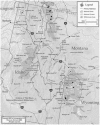Whitebark pine stand condition, tree abundance, and cone production as predictors of visitation by Clark's nutcracker
- PMID: 22662186
- PMCID: PMC3360761
- DOI: 10.1371/journal.pone.0037663
Whitebark pine stand condition, tree abundance, and cone production as predictors of visitation by Clark's nutcracker
Abstract
Background: Accurately quantifying key interactions between species is important for developing effective recovery strategies for threatened and endangered species. Whitebark pine (Pinus albicaulis), a candidate species for listing under the Endangered Species Act, depends on Clark's nutcracker (Nucifraga columbiana) for seed dispersal. As whitebark pine succumbs to exotic disease and mountain pine beetles (Dendroctonus ponderosae), cone production declines, and nutcrackers visit stands less frequently, reducing the probability of seed dispersal.
Methodology/principal findings: We quantified whitebark pine forest structure, health metrics, and the frequency of nutcracker occurrence in national parks within the Northern and Central Rocky Mountains in 2008 and 2009. Forest health characteristics varied between the two regions, with the northern region in overall poorer health. Using these data, we show that a previously published model consistently under-predicts the proportion of survey hours resulting in nutcracker observations at all cone density levels. We present a new statistical model of the relationship between whitebark pine cone production and the probability of Clark's nutcracker occurrence based on combining data from this study and the previous study.
Conclusions/significance: Our model clarified earlier findings and suggested a lower cone production threshold value for predicting likely visitation by nutcrackers: Although nutcrackers do visit whitebark pine stands with few cones, the probability of visitation increases with increased cone production. We use information theoretics to show that beta regression is a more appropriate statistical framework for modeling the relationship between cone density and proportion of survey time resulting in nutcracker observations. We illustrate how resource managers may apply this model in the process of prioritizing areas for whitebark pine restoration.
Conflict of interest statement
Figures




References
-
- Tomback DF, Arno SF, Keane RE. The compelling case for management intervention. In: Tomback DF, Arno SF, Keane RE, editors. Whitebark pine communities: Ecology and restoration. Washington: Island Press; 2001a. pp. 3–28.
-
- Ellison AM, Bank MS, Clinton BD, Colburn EA, Elliot K, et al. Loss of foundation species: consequences for the structure and dynamics of forested ecosystems. Frontiers in Ecology and the Environment. 2005;3:479–486.
-
- Tomback DF, Achuff P. Blister rust and western forest biodiversity: ecology, values, and outlook for white pines. Forest Pathology. 2010;40:186:225.
-
- U.S. Fish and Wildlife Service. Endangered and threatened wildlife and plants; 12-month finding on a petition to list Pinus albicaulis as Endangered or Threatened with critical habitat. Federal Register. 2011;76:42631–42654.
-
- Mahalovich MF, Burr KE, Foushee DL, Riley LE, Dumroese RK, Landis TD. Proceedings RMRS-P-43. Fort Collins: USFS Rocky Mountain Research Station; 2006. Whitebark pine germination, rust resistance, and cold hardiness among seed sources in the Inland Northwest: planting strategies for restoration.
Publication types
MeSH terms
LinkOut - more resources
Full Text Sources
Research Materials

